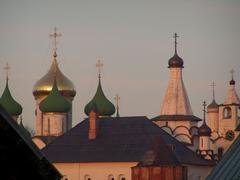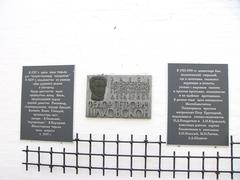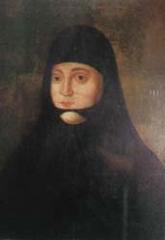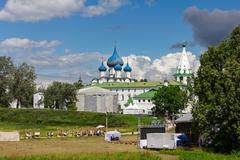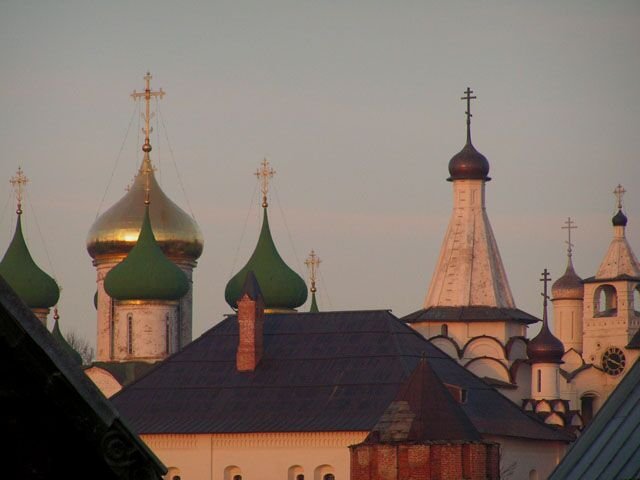
Monastery of Saint Euthymius Suzdal: Visiting Hours, Tickets & Complete Visitor Guide
Date: 14/06/2025
Introduction
The Monastery of Saint Euthymius in Suzdal is a striking symbol of Russia’s medieval heritage, blending spiritual significance, architectural grandeur, and a rich, multifaceted history. Founded in 1352, this UNESCO World Heritage Site commands the Kamenka River, serving as both a spiritual sanctuary and a defensive fortress throughout centuries of religious devotion, political upheaval, and artistic achievement. Today, the monastery is a focal point for cultural tourism, offering visitors the chance to explore centuries-old cathedrals, vibrant frescoes, formidable fortifications, and a sobering prison museum—all set within the enchanting town of Suzdal (UNESCO; Live the World; Russia eGuide).
This guide provides everything you need to plan your visit: opening hours, ticket information, guided tours, accessibility details, travel tips, and insights into the monastery’s cultural legacy and must-see highlights.
Table of Contents
- Historical Overview
- Architectural & Artistic Highlights
- Museum & Visitor Experience
- Practical Visitor Information
- FAQs
- Nearby Attractions
- Visual Gallery
- Conclusion and Recommendations
- Sources
Historical Overview
Foundation and Growth
Established in 1352, the Monastery of Saint Euthymius marked Suzdal’s emergence as a spiritual and administrative center in northeastern Russia. Named for its founder, Saint Euthymius, the monastery initially played both religious and defensive roles, with fortified walls protecting the town against external threats (UNESCO; Live the World).
Expansion and Cultural Flourishing
During the 16th and 17th centuries, the monastery expanded significantly with support from rulers like Vasili III and Ivan IV (Ivan the Terrible), and the influential Pozharsky family (Religion Fandom). Major additions included the seven-domed Cathedral of the Transfiguration of the Saviour, Assumption Church, and the imposing bell tower. The monastery became a hub of religious education, manuscript production, and the arts. Monastic workshops produced icons, vestments, and sacred objects, many of which can still be seen in the “Golden Treasurer” exhibition (Live the World).
Fortress and Prison
The monastery’s thick walls and towers served as a formidable fortress, withstanding numerous sieges. In 1764, a prison was established inside the complex, first for religious dissidents and later for political prisoners—most notably, it is rumored, German Field Marshal Friedrich Paulus during the Soviet era (Religion Fandom; Military History Fandom). This prison now houses a museum exploring its somber legacy.
UNESCO Recognition and Preservation
In 1992, the monastery was inscribed as part of the “White Monuments of Vladimir and Suzdal” UNESCO World Heritage Site, celebrated for its outstanding medieval architecture and cultural importance (UNESCO). Careful restoration has preserved the site’s original materials and authentic appearance.
Architectural & Artistic Highlights
Monastic Fortress: Walls and Towers
Originally constructed in wood, the 17th-century red-brick walls (up to 6 meters thick and 8.5 meters high) and 12 towers enclose the vast monastic grounds. The 22-meter entrance tower on the southern wall now serves as the main gateway and ticket office (Russia eGuide). The fortress-like design reflects the dual religious and military functions, strategically placed to oversee Suzdal’s approaches (Wikipedia).
Cathedral of the Transfiguration of the Saviour
This seven-domed white-stone cathedral (1594–1597) is the heart of the complex, renowned for its harmonious Vladimir-Suzdal architecture and vibrant frescoes painted by Gury Nikitin’s Kostroma school in 1689 (Miumiu UNESCO Cities). It also houses the tomb of Dmitry Pozharsky, a national hero who helped liberate Moscow in 1612 (Lonely Planet).
Assumption Church and Refectory
Built in 1525, the Assumption Church is unique for its integration with the monastic refectory, reflecting the cenobitic traditions of communal worship and daily life. The adjoining chambers display rare Russian manuscripts and folk art (Russia eGuide).
Bell Tower and Annunciation Gate Church
The 16th–17th century bell tower, with openwork arches and a multi-tiered design, offers scheduled peals that echo across Suzdal. The Annunciation Gate Church at the entrance hosts exhibitions on Pozharsky and other notable figures (Lonely Planet).
Frescoes and Iconography
The cathedral’s frescoes illustrate biblical scenes, saints, and apocalyptic visions, while the multi-tiered iconostasis features masterful 17th-century icons. These artworks are exceptional examples of Russian religious artistry (Spotting History; Live the World).
Museum & Visitor Experience
The monastery now operates as a museum complex with ten permanent exhibitions. Highlights include the “Golden Treasurer” (featuring gold, silver, and liturgical objects), the prison museum, original manuscripts, and monastic workshops (Live the World). Visitors can explore historic gardens, vegetable plots, and panoramic views of the Kamenka River (Quokka Travel).
Practical Visitor Information
Opening Hours
- April–October: 9:00 AM – 6:00 PM
- November–March: 10:00 AM – 5:00 PM
- Some references report: 10:00 AM – 6:00 PM, Tuesday to Sunday (closed Mondays). Confirm on the official website or with local tourism offices (Russia eGuide).
Tickets
- Adults: 400–500 RUB (varies by ticket type)
- Students/Seniors: Discounted rates
- Children under 16: Free
- Tickets cover entry to all main buildings, museums, and the prison museum. Purchase onsite or online when available.
Guided Tours
- Available in Russian and English. Advance booking recommended during peak seasons.
- Audio guides and virtual tours are also offered.
Accessibility
- Paved pathways and ramps provide wheelchair access to most main areas. Some historic structures have limited accessibility.
- Restrooms available on site.
Travel Tips
- Wear comfortable shoes for cobblestone and uneven paths.
- Photography allowed (no flash in churches/museums).
- Arrive early or late to avoid crowds.
FAQs
Q: What are the Monastery of Saint Euthymius visiting hours?
A: Generally 9:00 AM–6:00 PM (April–October), 10:00 AM–5:00 PM (November–March). Closed Mondays.
Q: How much are tickets?
A: 400–500 RUB for adults, discounts for students/seniors, free for children under 16.
Q: Are guided tours available in English?
A: Yes, book in advance for English-speaking guides.
Q: Is the monastery accessible for visitors with disabilities?
A: Most areas are accessible; some historic parts have limited access.
Q: Can I take photos?
A: Yes, except flash inside churches and museums.
Nearby Attractions
After your monastery visit, explore these Suzdal highlights:
- Suzdal Kremlin
- Museum of Wooden Architecture
- Pokrovsky Monastery
- Local crafts markets and cafes along Lenin Street
Visual Gallery
Images courtesy of the Vladimir-Suzdal Museum Reserve.
Conclusion and Visitor Recommendations
The Monastery of Saint Euthymius provides an immersive journey into Russia’s spiritual, cultural, and architectural past. Its UNESCO status attests to its global importance, while ongoing conservation ensures its legacy endures. Plan your visit by checking current hours and ticket options, consider a guided tour for deeper insight, and take time to enjoy the tranquil grounds and neighboring Suzdal attractions.
For more information, download the Audiala app for audio guides and updates, and follow us on social media for the latest news and travel tips.
Sources
- UNESCO World Heritage listing, 1992, UNESCO
- History of Russian Monasteries in Suzdal: The Russian Vatican, Live the World
- Monastery of Saint Euthymius, Russia eGuide
- Monastery of Saint Euthymius, Military History Fandom
- Spotting History - Saint Euthymius Monastery, Spotting History
- Lonely Planet - Saviour Monastery of St. Euthymius, Lonely Planet
- Miumiu UNESCO Cities - Suzdal Monastery, Miumiu UNESCO Cities
- Quokka Travel - Need to Know: Visit Suzdal, Quokka Travel
